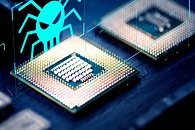Raevenlord
News Editor
- Joined
- Aug 12, 2016
- Messages
- 3,755 (1.34/day)
- Location
- Portugal
| System Name | The Ryzening |
|---|---|
| Processor | AMD Ryzen 9 5900X |
| Motherboard | MSI X570 MAG TOMAHAWK |
| Cooling | Lian Li Galahad 360mm AIO |
| Memory | 32 GB G.Skill Trident Z F4-3733 (4x 8 GB) |
| Video Card(s) | Gigabyte RTX 3070 Ti |
| Storage | Boot: Transcend MTE220S 2TB, Kintson A2000 1TB, Seagate Firewolf Pro 14 TB |
| Display(s) | Acer Nitro VG270UP (1440p 144 Hz IPS) |
| Case | Lian Li O11DX Dynamic White |
| Audio Device(s) | iFi Audio Zen DAC |
| Power Supply | Seasonic Focus+ 750 W |
| Mouse | Cooler Master Masterkeys Lite L |
| Keyboard | Cooler Master Masterkeys Lite L |
| Software | Windows 10 x64 |
Ouch doesn't even begin to describe how much that headline hurt. As far as speculative execution goes, it's been well covered by now, but here's a refresher. Speculative execution essentially means that your CPU tries to think ahead of time on what data may or may not be needed, and processes it before it knows it's needed. The objective is to take advantage of concurrency in the CPU design, keeping processing units that would otherwise be left idle to process and deliver results on the off-chance that they are indeed required by the system: and when they are called for, the CPU saves time by not having to process them on the fly and already having them available.
The flaws have been announced by Intel in coordination with Austrian university TU Graz, Vrije Universiteit Amsterdam, the University of Michigan, the University of Adelaide, KU Leuven in Belgium, Worcester Polytechnic Institute, Saarland University in Germany and security firms Cyberus, BitDefender, Qihoo360 and Oracle. While some of the parties involved have named the four identified flaws with names such as "ZombieLoad", "Fallout", and RIDL, or "Rogue In-Flight Data Load", Intel is using the PEGI-13 "Microarchitectural Data Sampling (MDS)" name.

Update May 15th: Intel has released benchmarks that show the performance impact of the MDS mitigations.
Update May16th: Apparently Intel tried to swipe the issue under the rug with a generous donation to the researchers.
The issue at hand here, defined by Intel's pretty tame MDS, is that like other side-channel attacks, exploits may allow hackers to obtain information that was otherwise deemed secure, had it not been run through the CPU's speculative execution processes. While Meltdown read sensitive information that was being stored in memory due to the speculative execution functions on Intel's CPUs, MDS attacks read the data on the CPU's various buffers - between threads, along the way to the CPU cache, and others. The researchers say that this flaw can be used to siphon data from the CPU at a rate that can approach real-time, and can be used to selectively pull what information is deemed important: whether it's passwords or what websites the user is visiting at the moment of the attack, it's all fair game.
Intel says that significant software changes will be needed to harden systems against this exploit, not only from themselves, but from operating system vendors and third party app creators. One of the proposed solutions is that every time a processor would switch from one third-party app to another, from a Windows process to a third-party app, or even from less trusted Windows processes to more trusted ones, the buffers have to be cleared or overwritten. This means a whole new cycle of data gathering and writing beings every time you call up a different process - and you bet that carries a performance penalty, which Intel is putting at a "minimal" up to 9%.
Intel detailed the vulnerability in its whitepaper and admitted that disabling HT might be warranted as a protection against MDS attacks - and you can imagine how much the company must have loathed to publish such a thing. Intel's HT has been heavily hit by repeated speculative execution flaws found on Intel processors, with mitigations usually costing some sort of performance on Intel's concurrent processing technology. Intel says its engineers discovered the MDS vulnerabilities last year, and that it has now released fixes for the flaw in both hardware and software. Although obviously, the software fixes will have to be deployed either on microcode updates or will have to be implemented by every operating system, virtualization vendor, and other software makers.
Intel also said that its 8th and 9th generation processors already include the hardware mitigations that defeat the exploitation of MDS, but previous architectures back to Nehalem are vulnerable. But why play it on expectations: you can take a test that has been published by the researchers right here.
The CVE codes for the vulnerabilities stand as such:
View at TechPowerUp Main Site
The flaws have been announced by Intel in coordination with Austrian university TU Graz, Vrije Universiteit Amsterdam, the University of Michigan, the University of Adelaide, KU Leuven in Belgium, Worcester Polytechnic Institute, Saarland University in Germany and security firms Cyberus, BitDefender, Qihoo360 and Oracle. While some of the parties involved have named the four identified flaws with names such as "ZombieLoad", "Fallout", and RIDL, or "Rogue In-Flight Data Load", Intel is using the PEGI-13 "Microarchitectural Data Sampling (MDS)" name.

Update May 15th: Intel has released benchmarks that show the performance impact of the MDS mitigations.
Update May16th: Apparently Intel tried to swipe the issue under the rug with a generous donation to the researchers.
The issue at hand here, defined by Intel's pretty tame MDS, is that like other side-channel attacks, exploits may allow hackers to obtain information that was otherwise deemed secure, had it not been run through the CPU's speculative execution processes. While Meltdown read sensitive information that was being stored in memory due to the speculative execution functions on Intel's CPUs, MDS attacks read the data on the CPU's various buffers - between threads, along the way to the CPU cache, and others. The researchers say that this flaw can be used to siphon data from the CPU at a rate that can approach real-time, and can be used to selectively pull what information is deemed important: whether it's passwords or what websites the user is visiting at the moment of the attack, it's all fair game.
Intel says that significant software changes will be needed to harden systems against this exploit, not only from themselves, but from operating system vendors and third party app creators. One of the proposed solutions is that every time a processor would switch from one third-party app to another, from a Windows process to a third-party app, or even from less trusted Windows processes to more trusted ones, the buffers have to be cleared or overwritten. This means a whole new cycle of data gathering and writing beings every time you call up a different process - and you bet that carries a performance penalty, which Intel is putting at a "minimal" up to 9%.
Intel detailed the vulnerability in its whitepaper and admitted that disabling HT might be warranted as a protection against MDS attacks - and you can imagine how much the company must have loathed to publish such a thing. Intel's HT has been heavily hit by repeated speculative execution flaws found on Intel processors, with mitigations usually costing some sort of performance on Intel's concurrent processing technology. Intel says its engineers discovered the MDS vulnerabilities last year, and that it has now released fixes for the flaw in both hardware and software. Although obviously, the software fixes will have to be deployed either on microcode updates or will have to be implemented by every operating system, virtualization vendor, and other software makers.
Intel also said that its 8th and 9th generation processors already include the hardware mitigations that defeat the exploitation of MDS, but previous architectures back to Nehalem are vulnerable. But why play it on expectations: you can take a test that has been published by the researchers right here.
The CVE codes for the vulnerabilities stand as such:
- CVE-2018-12126 Microarchitectural Store Buffer Data Sampling (MSBDS)
- CVE-2018-12130 Microarchitectural Fill Buffer Data Sampling (MFBDS)
- CVE-2018-12127 Microarchitectural Load Port Data Sampling (MLPDS)
- CVE-2019-11091 Microarchitectural Data Sampling Uncacheable Memory (MDSUM)
View at TechPowerUp Main Site








